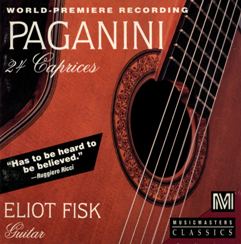Niccolo Paganini – 24 Caprices For Guitar (Eliot Fisk) [1992]
Niccolo Paganini – 24 Caprices For Guitar (Eliot Fisk) [1992]

1. No. 1, Andante in E major 2. No. 2, Moderato in B minor 3. No. 3, Sostenuto - Presto - Sostenuto in E minor 4. No. 4, Maestoso in C minor 5. No. 5, Agitato in A minor 6. No. 6, Lento in G minor 7. No. 7, Posato in A minor 8. No. 8, Maestoso in E flat major 9. No. 9, Allegretto in E major, "The Hunt" 10. No. 10, Vivace in G minor 11. No. 11, Andante - Presto - Tempo I in C major 12. No. 12, Allegro in A flat major 13. No. 13, Allegro in B flat major, "The Devil's Chuckle" 14. No. 14, Moderato in E flat major 15. No. 15, Posato in E minor 16. No. 16, Presto in G minor 17. No. 17, Sostenuto - Andante, in E flat major 18. No. 18, Corrente - Allegro in C major 19. No. 19, Lento - Allegro assai in E flat major 20. No. 20, Allegretto in D major 21. No. 21, Amoroso - Presto in A major 22. No. 22, Marcato in F major 23. No. 23, Posato in E flat major 24. No. 24, Tema - Quasi presto (11) Variazioni - Finale in A minor Eliot Fisk - Guitar, Transcription
Guitarist, Eliot Fisk is not the first musician outside the violin playing fraternity to become preoccupied with Paganini’s 24 Caprices. Schumann, Liszt and Rachmaninoff incorporated aspects of these masterpieces into their own compositions. Unlike much of Paganini’s original work, they were actually published during his lifetime, appearing in 1820. It has been suggested that they were probably inspired by the cadenza-like caprices that form the twelve violin concertos of Locatelli, Op.3, published in 1732.
These caprices remain a supreme test of a violinist’s virtuosity and explore virtually every aspect of violin technique: legato, staccato, spiccato, tremolo, harmonics, trills, arpeggios, scales, left-hand pizzicato, and multiple stoppings - thirds, sixths, tenths and octaves.
The task of arranging this music for the guitar is challenging to say the least, and deviation from the standard guitar technique is required for execution of some of the caprices. Mr. Fisk feels that numbers two and twelve are more idiomatic to the guitar and multiple stoppings that feature prominently throughout the set, are much more natural on the guitar's six strings than the violin's four. That said, there are occasions when some of the arrangements convey a feeling of uneasiness and that adaptation may be incongruous with the guitar.
Guitarist, Kazuhito Yamashita embraced similar challenges when he adapted and arranged Mussorgsky’s Pictures at an Exhibition for the guitar (RCA ARC1-4203). While its execution also requires innovation beyond standard repertory technique, his rendition leaves one with a feeling of compatibility and fait accompli. An audition of Mr. Kazuhito’s arrangement for guitar of the Beethoven Violin Concerto Op 61 (RCA RL 70847), is less convincing, albeit intriguing and beguiling. It is not the amazing technical capability of Kazuhito that is in question, but the relevance of this latter work to such adaptation no matter how well played on the guitar.
While Eliot Fisk appears to be the only guitarist to have recorded all twenty-four of the caprices on what is a re-release of a 1992 recording, numerous other guitarists have recorded one or several. A memorable example of Caprice No. 24 can be found on an early vinyl pressing by John Williams (CBS SBR 235417) and some subsequent re-releases. More recently Marco Tamayo included Caprices 5, 11 and 24 on his Naxos recording of Paganini (8.557598) that has also been reviewed in this forum.
As with the violin, these arrangements for guitar require high levels of virtuosity. Even John Williams was once noted to have almost come unstuck in a performance of Caprice No. 24. In several of the caprices, as arranged and played by Eliot Fisk, one gets an impression that they are either unsuitable for playing on the guitar or the musician has been stretched beyond his technical capabilities. In contrast Marco Tamayo’s renditions are so well executed that they sound like original works for the guitar; John Williams’ rendition of No. 24 is similarly illusionary. A reasonable observation is that Mr. Fisk may have bitten off more, technically, than he can chew.
A hallmark of virtuosity is precise and accurate execution of certain passages very quickly, and exercising good musical judgement within the context of the music. Laudable though his arrangements and intentions may be, Mr. Fisk fails to give a convincing performance in those caprices that require execution within the criteria defined. Some, irrespective of the speed at which they are traditionally played on the violin, may benefit in his hands if their tempi were decreased, and winning the Paganini Derby given a lower priority.
As a definitive collection of the twenty-four Paganini Caprices, arranged for the guitar, this is an interesting and worthwhile recording. There are, however, superior recordings of several of the caprices by other guitarists. ---Zane Turner, musicweb-international.com
download: uploaded yandex 4shared mediafire solidfiles mega filecloudio nornar ziddu
Last Updated (Friday, 07 March 2014 16:14)








